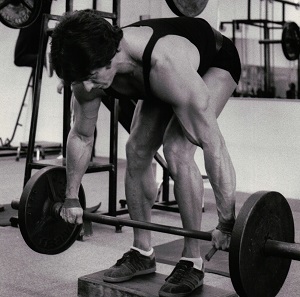The Dead-lift
“Hey Mom, watch me lift 300 pounds” I yelled from my cellar gym. Worried I’d hurt myself, my mother ran downstairs to witness me dead-lift the ponderous weight. Not bad for a 17-year-old.
But dead lifting wasn’t my thing. Just the name of the exercise brought unpleasant associations to my mind. “I’d better change my attitude toward this lift. Since it exists and people do it there must be some kind of benefit to it.” I said to myself. The dead-lift was the heaviest of the power-lifts and one of the best exercises to built back strength and muscle thickness.
The best I ever did in power-lifting competition was 425 at a body-weight of 175 in 1962. I went on to place second with a curl of 165 and a bench press of 275 and win the Mr. Keystone State title, my first first place finish. I was only interested in the lifts that promoted my physical development. But I continued to train at dead-lifting and hurt my lower back by coming up crooked in the lift. That was the end of my dead lifting for quite some time.
It wasn’t until I trained for the 1979 Olympia that I began incorporating dead-lifts into my workouts. What I was after was wider shoulders, thicker lats and spinal erectors, and thicker traps especially in the area between the shoulder blades. In conversations with Steve Reeves before he passed away years ago, he told me how he did wide grip dead-lifts by holding on to the protruding lip of the 45-pound Olympic plates he put on the 7-foot bar backwards. He was quite strong, using well over 300 pound this way.
Well, if it was good enough for Reeves, it certainly was something I wanted to do. The grip was the problem, my hands hurt using any kind of weight this way. But I had to find a way to do this dead-lift, just look what it did for Reeves. I didn’t want to use the typical dead-lift grip where one hand is held in an over grip, while the other is completely supinated with the palm facing away from the body in an under grip. I’ve seen power lifters tear the biceps on this arm, not something anyone should risk.
So, I began doing dead-lifts with an overhand wide grip using weightlifting straps to assist my grip, working up in weight each set. My first was 135 for 15, 185 x 12, 225 x 10; then I’d put the bar on a power rack so that it touched the tops of my knees, rubbed oil on my thighs and slid the bar up them. I typically did 275 x10, 315 x 8, 365 x 7, 405 x 6. My very best effort came in 1982 training for Mr. O with an effort of 5 reps with 555.
My back became wide and thick, but the lift was dangerous. I made sure to do a very slow negative so I would touch the power rack pins with each side of the bar at exactly the same time. Several times I touched one side before the other and injured my lower back, which is easy to do with a heavy weight.
A safer way to do this exercise is on the Smith Machine because the bar runs on a track and doesn’t touch anything at the bottom. There is no danger of coming up crooked when you do this exercise on a Smith machine. I’d keep the bar in contact with my thighs the whole time lowering the bar to a point right at the tops of my knees. If you want a wider upper body, you might want to do Smith Machine top dead-lifts. It’s safer than using a power rack.
Here are the essential for safe dead-lifting:
- Warm up the lower back with two sets of 15 reps in the hyper-extension.
- Use a lifting belt to keep your lower back warm.
- Take an overhand grip slightly wider than shoulder width.
- Use weightlifting straps or hooks. This makes the wide grip more comfortable.
- Work up to 3 sets of 10, 8, 6 reps from the floor (regular dead-lift) then go to 3 sets of 10, 8, 6 reps on the power rack or Smith machine for top dead-lift from the knees up.
- Keep the bar close to the shins from start to knees and touching thighs after bar crosses knees.
- Rub oil or baby powder on thighs to reduce bar sliding friction. Wear high socks so bar won’t bruise shins.
- Lean slightly backward at finish and then slowly lower the weight to starting point rounding the back and flexing the lats, stretching at the bottom.
- Inhale on way up, exhale down. Don’t hold your breath.


